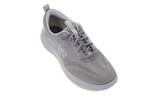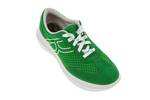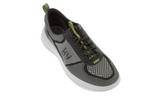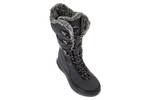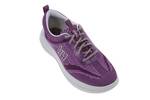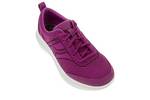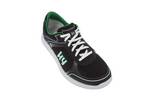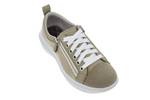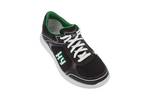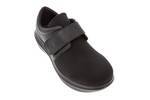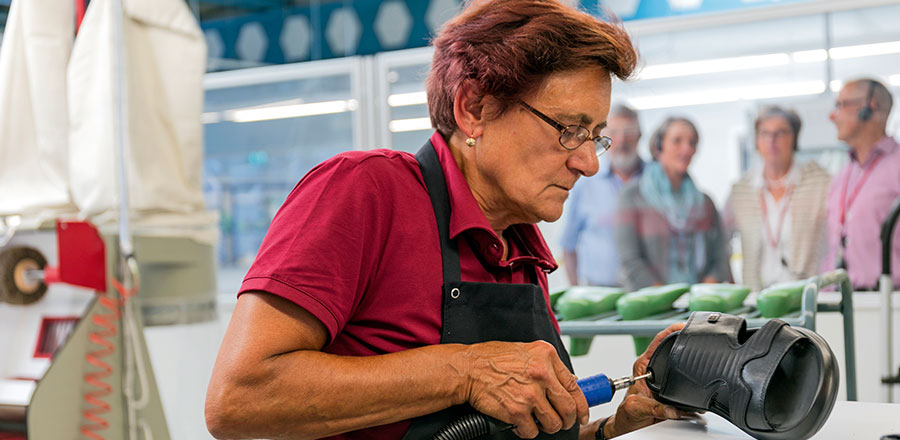
Upper material: Microfibre, mesh, velour leather, nubuck leather, smooth leather
Lining: Leather, microfibre, Lycra, mesh, velour leather
Insole: Mesh, velour leather
Sole: Polyurethane
Where does the leather come from?
We only source leather from suppliers who meet established requirements for the protection of people and the environment, and we also ensure that the leather contains no residues of illegal substances. We can confidently say that our products meet these standards.
We currently source leather from Argentina and Australia. The leather is tanned in Italy (see ‘origin/production’).
Does the leather contain chromates?
Well over 95 per cent of all leather processed by the shoe industry is tanned with chromium; this is also the case with the leather used by kybun. Chromium residue in itself is acceptable and non-toxic according to international norms and standards. Only chromium (IV) is regulated, and we abide by those regulations, of course: No traces of chromium (IV) are allowed.
We recommend that our customers who are allergic to all chromates use the ‘Product overview’ to select one of our models without leather. These are always free of chromates.
Will the colour of the leather in kybun products fade?
Shoes with dyed leather may lose their colour at first. This has nothing to do with the colour of the leather or how the manufacturer produces the shoes. There are many possible reasons for loss of colour.
The most common reason is the use of environmentally friendly dyes and fixing agents. It is also possible that the colours were not sufficiently washed off or fixed at the tannery. Dampness or unusually large amounts of sweat from feet may also be a contributing factor for colour fading.
This colour fading could only be prevented if our production process involved the use of chemicals, some of which are hazardous. In order to protect the environment and our customers, kybun AG does not use such substances.
However, you can prevent or minimise loss of colour and its consequences by taking the following measures.
- Use care products to prevent colour loss, for example, ‘Woly Anti Color’ spray.
- Avoid wearing socks with colours that are lighter than the colour of the leather.
- Do not wash the lining or bring it in contact with liquid.
- Ensure the shoes are sufficiently aired and dried out after each use.
The dyeing of leather shoes can be compared to the dyeing of laundry. There are no 100% wash perfect textiles or leather. All these colours can experience levels of discolouring, which is a normal ageing process of the material. Glossy leather is easier to manage. Our leather is deliberately not glossy, so that it is less slippery and more comfortable to wear. In the interest of our customer's health, the "leather" is treated with chemicals as little as possible. This is similarly the case by other shoe brands (e. g. GEOX). When feet are dry, discolouring occurs less than when feet are moist or creamed.
Origin and production of leather at kybun AG
kybun AG mainly uses leather from Europe, North America and South America to make the uppers of its kybun shoe. A small proportion of our leather goods come from South Korea and India. Conditions in leather-making plants in India came under fire in an item broadcast by SRF in its ‘Kassensturz’ programme on 16 December 2014, which showed images that were hard to stomach. kybun AG has no association whatsoever with such production processes and conditions. It is important to kybun AG, however, that following this disturbing item, not all tanneries are cast in such a poor light. Even before the critical spotlight fell on leather production, kybun AG has always cared about animal welfare and production conditions at its various suppliers. In light of the TV programme, we have again reviewed our relationship with the Indian tannery and cooperation will continue, with a clear conscience.
Our Indian supplier is a joint venture with a well-known Italian tannery. Managers have given their assurances that the allegations made in the consumer affairs programme are in no way connected to their operation. The tannery does not buy skins from such slaughterhouses. It treats staff well and complies with EU health and environment rules. It also guarantees that the leather contains no banned substances.
As you know, people’s well-being is at the heart of what kybun AG does. It is what drives the company. By producing products that are beneficial to health such as the kybun shoe, kybun mat and kybun treadmill, our aim is to make a positive contribution to people’s lives. In this respect, kybun AG is not only concerned about the health of its end customers and staff. It also makes every effort to ensure that working conditions are as good as possible for those working for its suppliers. Wherever in the world they may be. This is one of the reasons why kybun AG has no wish and is not in a position to pursue a low-price strategy – not least to protect people, animals and the environment. Such an approach to sustainable production comes at a price, but this price is worth it for us.
kybun AG would like to thank its similarly health-minded customers for their loyalty and therefore for supporting production processes that promote people’s health in keeping with our times and values.

